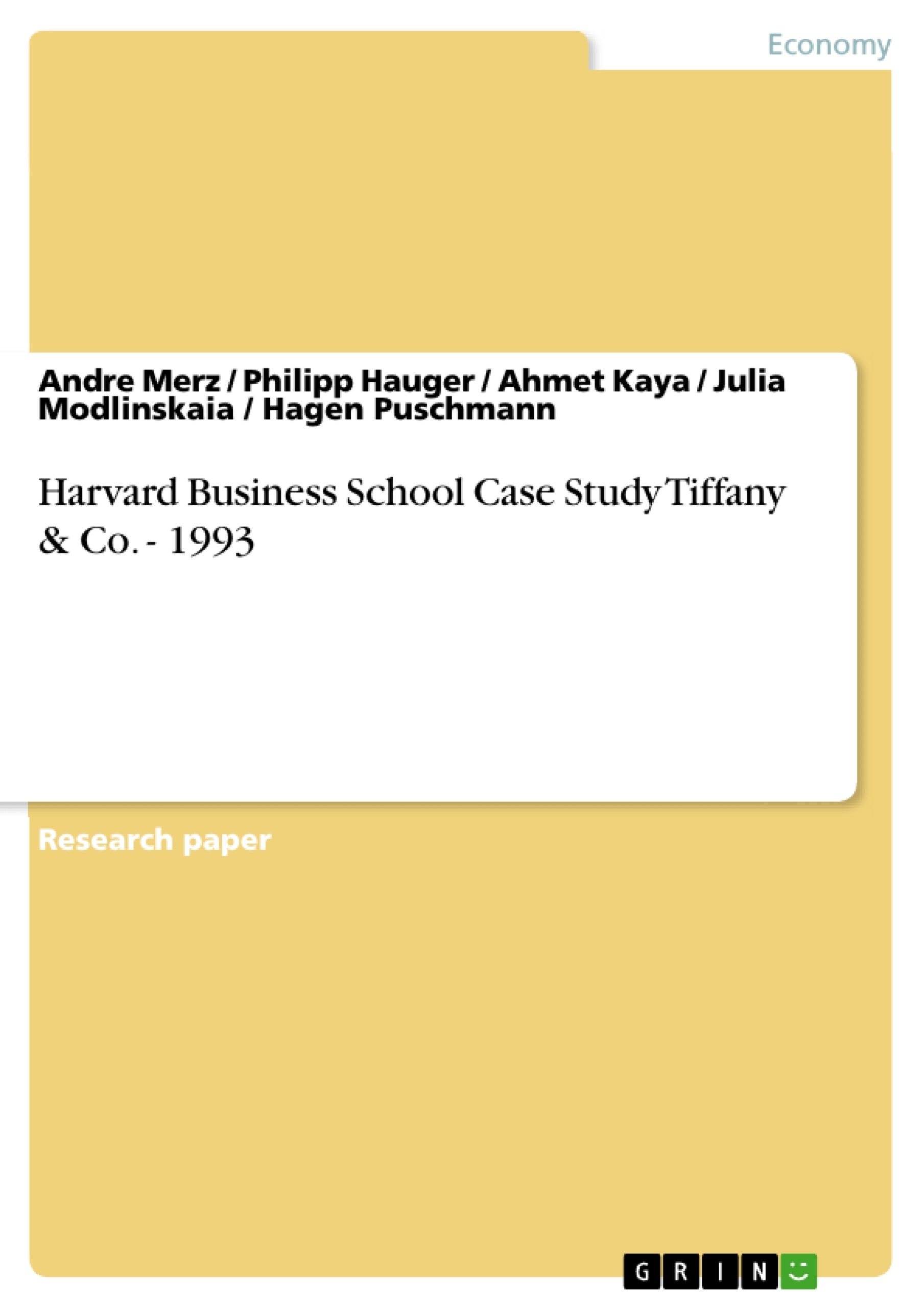In the context of Harvard Business Case Tiffany & Co. 1993 our team will focus on the Identification, Measurement, Management of the JPY/USD exchange rate in terms of Economic, Transaction and Translation Exposures for Tiffany & Co. 2. Economic Overview: Japan in 1993: In the decade of 1960s Japan faced various trade frictions with the USA and Europe in connection with rapid expansion of industrial products exports. In 1971, the USA decided to end the convertibility of the USD into gold. Therefore the fixed exchange rate regime (namely Bretton Woods System) was not in place anymore. Japan’s reaction was to float its exchange rate from JPY 360 to JPY 308 in December 1971. In February 1973, the Japanese yen moved to the floating exchange-rate system. The Japanese Economy faced a steady growth until October 1973, as the Israeli-Arab War in this year lead to the first oil crisis, and it triggered a high inflation. As a result, Japan's economy recorded negative growth in 1974 for the first time in the post-war period
Inhaltsverzeichnis (Table of Contents)
- Preface
- Economic Overview: Japan in 1993
- FX-Exposure
- Economic Exposure
- Transaction Exposure
- Translation Exposure
- Organizational consequences for Tiffany & Co. on the basis of our recommendation
- Update on Tiffany's FX-Exposure
Zielsetzung und Themenschwerpunkte (Objectives and Key Themes)
This case study analyzes Tiffany & Co.'s exposure to Japanese Yen/US Dollar (JPY/USD) exchange rate fluctuations in 1993. The primary objective is to identify, measure, and manage the economic, transaction, and translation exposures faced by the company. The analysis considers the economic context of Japan in 1993 and its implications for Tiffany & Co.'s operations.
- Economic conditions in Japan during 1993
- Analysis of Tiffany & Co.'s FX exposure (Economic, Transaction, and Translation)
- Impact of JPY/USD exchange rate on Tiffany & Co.'s financial performance
- Strategies for managing currency risk
- Assessment of the company’s overall financial health in relation to these risks.
Zusammenfassung der Kapitel (Chapter Summaries)
Preface: This section provides a brief introduction to the case study, outlining the team's focus on identifying, measuring, and managing Tiffany & Co.'s exposure to the JPY/USD exchange rate across economic, transaction, and translation exposures.
Economic Overview: Japan in 1993: This chapter provides a historical overview of the Japanese economy, highlighting key events such as trade frictions with the US and Europe in the 1960s, the end of the Bretton Woods system in 1971, and the subsequent shift to a floating exchange rate system. It details Japan's economic growth until the 1973 oil crisis, followed by periods of expansion and then contraction in the 1980s. The chapter culminates in an analysis of the Japanese economy in 1993, characterized by economic stagnation, rising unemployment, and a depreciating Yen, despite a high current account surplus. This economic context sets the stage for understanding Tiffany & Co.'s exposure to currency risk.
FX-Exposure: This chapter introduces the three main categories of foreign exchange exposure: economic, transaction, and translation exposure. It establishes a framework for analyzing Tiffany & Co.'s vulnerability to exchange rate fluctuations. The division of the exposure into these three categories allows for a more granular approach to understanding and managing the risks.
Organizational consequences for Tiffany & Co. on the basis of our recommendation: This chapter (whose content is not available in the provided text) would likely detail specific recommendations for Tiffany & Co. based on the analysis of their FX exposure. It would suggest strategies for mitigating the risks identified, perhaps including hedging strategies, adjustments to operational practices, or diversification.
Update on Tiffany's FX-Exposure: This chapter (whose content is not available in the provided text) would likely present an updated assessment of Tiffany & Co.'s FX exposure, considering the effectiveness of any implemented recommendations and evolving economic circumstances.
Schlüsselwörter (Keywords)
Tiffany & Co., JPY/USD exchange rate, foreign exchange exposure, economic exposure, transaction exposure, translation exposure, Japan, 1993, economic overview, currency risk management, financial risk.
Tiffany & Co. Case Study: Frequently Asked Questions (FAQ)
What is the main topic of this case study?
This case study analyzes Tiffany & Co.'s exposure to fluctuations in the Japanese Yen/US Dollar (JPY/USD) exchange rate during 1993. It focuses on identifying, measuring, and managing the company's economic, transaction, and translation exposures to currency risk.
What are the key themes explored in the case study?
The key themes include the economic conditions in Japan during 1993, a detailed analysis of Tiffany & Co.'s foreign exchange (FX) exposure across its economic, transaction, and translation components, the impact of JPY/USD exchange rate movements on the company's financial performance, strategies for managing currency risk, and an assessment of the company's overall financial health in light of these risks.
What are the three types of foreign exchange exposure discussed?
The case study examines three main types of FX exposure: economic exposure (the impact of exchange rate changes on a company's future cash flows), transaction exposure (the risk associated with future contractual cash flows denominated in a foreign currency), and translation exposure (the impact of exchange rate changes on the reported financial statements of a company with foreign operations).
What was the economic situation in Japan during 1993?
The case study provides a historical overview of the Japanese economy leading up to 1993, highlighting key events and periods of growth and contraction. In 1993, the Japanese economy was characterized by stagnation, rising unemployment, and a depreciating Yen, despite a high current account surplus. This context is crucial for understanding Tiffany & Co.'s currency risk.
What is the purpose of the "Organizational consequences for Tiffany & Co. on the basis of our recommendation" chapter?
This chapter (content unavailable in the provided text) would detail recommendations for Tiffany & Co. based on the FX exposure analysis. It would likely suggest strategies for mitigating identified risks, potentially including hedging strategies, operational adjustments, or diversification.
What is the purpose of the "Update on Tiffany's FX-Exposure" chapter?
This chapter (content unavailable in the provided text) would likely present an updated assessment of Tiffany & Co.'s FX exposure, evaluating the effectiveness of any implemented recommendations and considering changes in economic conditions.
What are the key takeaways from the case study's analysis?
The key takeaways would involve a comprehensive understanding of Tiffany & Co.'s vulnerability to currency risk in 1993, the specific methods for measuring and analyzing different types of FX exposure, and the potential strategies for mitigating these risks to improve the company's financial stability.
What keywords are associated with this case study?
Key words include Tiffany & Co., JPY/USD exchange rate, foreign exchange exposure, economic exposure, transaction exposure, translation exposure, Japan, 1993, economic overview, currency risk management, and financial risk.
- Citation du texte
- Andre Merz (Auteur), Philipp Hauger (Auteur), Ahmet Kaya (Auteur), Julia Modlinskaia (Auteur), Hagen Puschmann (Auteur), 2005, Harvard Business School Case Study Tiffany & Co. - 1993, Munich, GRIN Verlag, https://www.grin.com/document/54657




